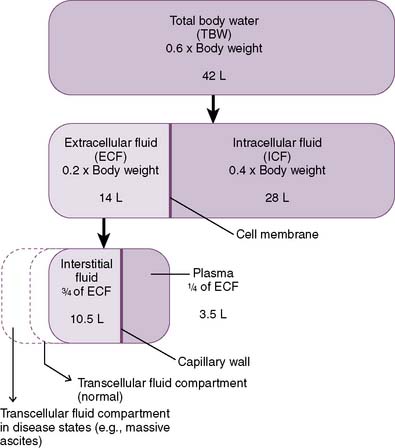Chapter 9 Sodium and Water Balance, Fluid Compartments
I. Body Fluids
A. Distribution of body fluids
1. Fluid compartments (Fig. 9-1)
• Approximately 50% to 60% of total body weight consists of water (approximately 50% in women, 60% in men, and 70% in infants).


9-1 Fluid compartments in the “typical” 70-kg man.
(From Levy MN, Koeppen BM, Stanton BA: Berne & Levy Principles of Physiology, 4th ed. Philadelphia, Mosby, 2007, Fig. 38-1.)
• Roughly two thirds of total body water (TBW) is located within cells (intracellular fluid, ICF), with the remainder located in the extracellular fluid (ECF) compartment.
• The ECF is composed of interstitial fluid (IF; ~75%) and plasma (~25%), with a minute fraction consisting of transcellular fluids.
• Transcellular fluids include many small fluid compartments such as the peritoneal, pleural, synovial, pericardial, and cerebrospinal fluids and the aqueous humor of the intraocular compartment.
2. Composition of fluid compartments
• Intracellular fluid
a. Relative to ECF, the ICF has large amounts of protein, potassium, calcium, and phosphate and low levels of sodium and chloride.
b. Approximately 98% of total body potassium is located within cells; this potassium can play an important role in buffering of a metabolic acidosis.
c. Most total body phosphate is also located within cells; this phosphate is important in adenosine triphosphate (ATP) generation as well as in intracellular buffering.
d. The large amounts of proteins are necessary for cellular function and also play an important buffering and osmotic role.
• Extracellular fluid
a. Interstitial fluid
• Interstitial fluid is separated from the plasma compartment by a barrier that is freely permeable to water and many electrolytes but not to red blood cells (RBCs) and most proteins.
• Interstitial fluid has high amounts of sodium and chloride and low amounts of potassium and phosphate; it is also relatively protein poor because of the selectively permeable capillary plasma membrane.



